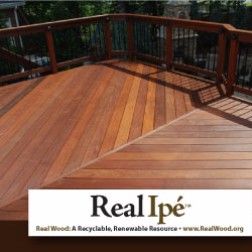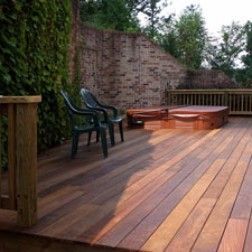
IPE DECKING
Ipe Decking: Information, Facts and Benefits
Ipe decking is one of the most popular and high quality choices of the Brazilian Hardwoods. Here on this page, you'll learn more about Ipe wood decking, the benefits it provides and other useful information to help get you started.
Benefits of Ipe Decking
Ipe wood, which is also known alternately as Brazilian Walnut, Ironwood or Pau lope, is extremely durable and sturdy, with a Janka hardness of 3680. That's triple the strength of a typical plastic-composite decking, while providing all of the aesthetic benefits of a natural, beautiful wood deck.
That strength comes in part through its density. Ipe is heavy enough to sink in water, but most importantly, it has a class A fire rating, which is amazingly the same rating as concrete, providing a safe and long-lasting choice.
Ipe decking is well known for its natural beauty. Featuring a tight grain with pronounced patterns, it has few to zero visible knots. Ipe is striking enough to be used for beautiful artistic projects within the home, such as high quality cabinets or interior trim, which provides a rare combination considering its strength and durability which easily serves larger commercial needs as well.
Ipe wood decking is also exceedingly versatile. Its durability makes it a natural choice for commercial projects, such as high-traffic, large-scale beach piers or boardwalks, or even public benches. However, its beauty, strength and low needs for maintenance also make it an advantageous choice for a home deck.
Ipe decking(pronounced E-pay) is world renowned for its superior characteristics and properties. Ipe wood decking grain is extremely dense and tight. Ipe wood grain can be both wavy and straight. The color of Ipe heartwood is a rich brown with red and amber hues. Due to the wood's fine texture and interlocking grain, Ipe offers superior slip resistance.
Another benefit of Ipe does not require the usage of preservatives or treatments, and is naturally resistant to a variety of common decking issues, such as decay and rot, insect infestation, and more.
Ipe wood decking boards come in numerous colors. This offers a natural and varied look which ranges from a light or tan brown, to dark olive or even a rich, nearly black, brown.
By the Numbers
Consider that Ipe wood decking has the aforementioned 3,680 Janka hardness rating, compared to 690 for pine and between 940 and 1,390 for composite-plastic. It also leads the way in shear strength, at 2,060, compared to 1,370 or between 561 and 1,010 respectively, and bending strength, at an enormous 25,400 psi, compared to just 9,900 to 14,500, or 1,423 to 4,500, for pine and composite respectively.
An Ipe deck compares favorably to two of the most popular, traditional choices for residential decks, pine softwood and composite-plastic decking.
Working with Ipe Decking
Ipe dries easily, and common concerns such as warping and cracking are minimal to nonexistent. With its great density and strength, shrinkage after installation is also minimal.
Joists and support beams can consist of more affordable pressure treated pine. The Ipe decking below will provide protection from the elements, improving the durability of the pine underneath, and allowing you to save money.
Proper Ipe installation
Utilizing spacers or stickers between boards will allow air to provide natural drying, and climate acclimation after shipping is also recommended before installation -- as little as less than one eighth of an inch of space should be left between boards. Additionally, Ipe wood decking should have room for ventilation underneath the deck boards themselves.
Other design and installation considerations for Ipe deck material will include choices in fasteners, such as whether or not to use hidden fasteners, and choice in deck railings and balusters, or vertical pickets.
Real Ipe compared to other decking materials
| RealIpe | CCA-Treated Pine | Composite Decking | |
|---|---|---|---|
| Type | Hardwood | ||
| Maintenance | Low | ||
| Decay Resistance | High | Varies | Varies |
| Termite Resistance | High | Varies | Varies |
| Strength | High | Medium | Low |
| Movement in Service | Low | High | High |
| Fire Rating Class | High | Varies | Low |
| Weight per Cu Ft. | 69 lbs. | 35 lbs. | 60-64 lbs. |
| Bending Strength | 25,400 psi | 9,900-14,500 psi | 1,423-4,500 psi |
| Shear Strength | 2,060 | 1,370 | 561-1,010 |
| Hardness | 3,680 | 690 | 940-1,390 |
For a more comprehensive comparison of decking materials,visit: CompositeDecking vs. RealWood



